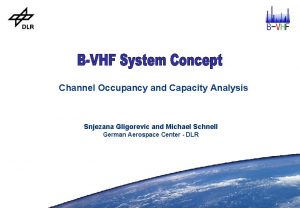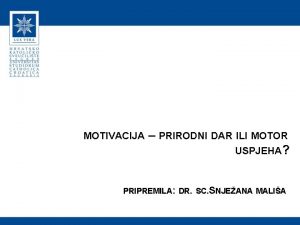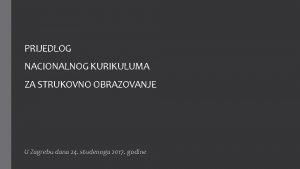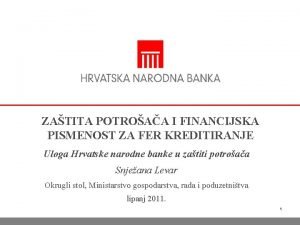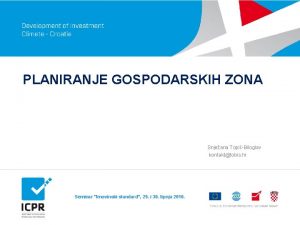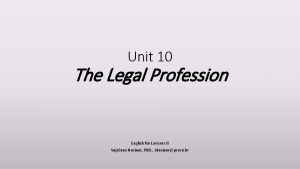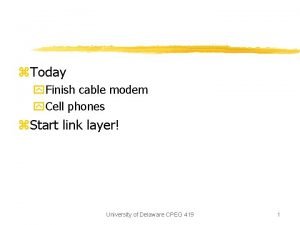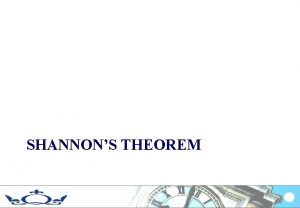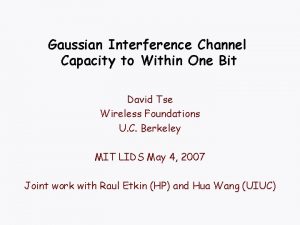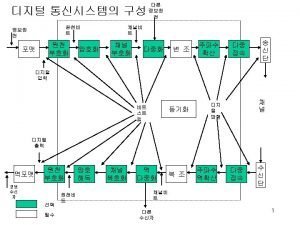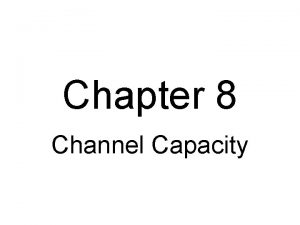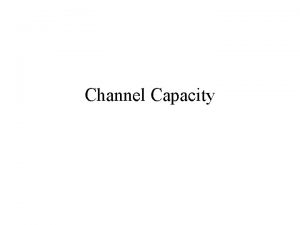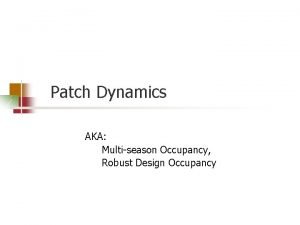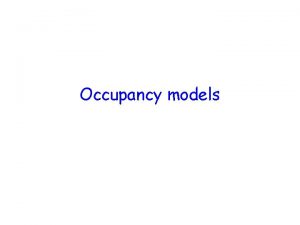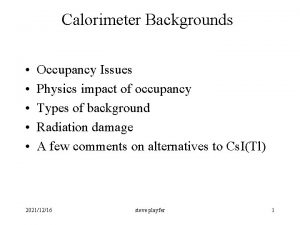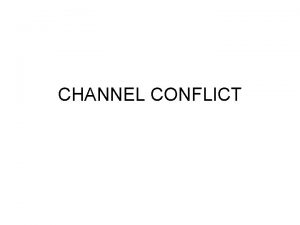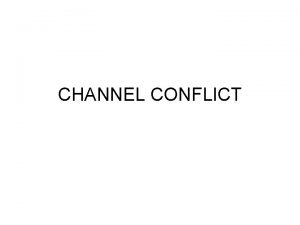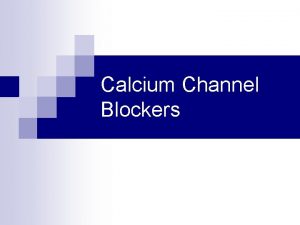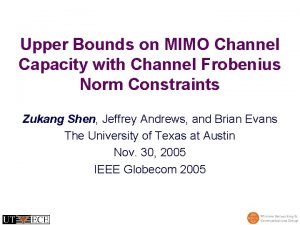Channel Occupancy and Capacity Analysis Snjezana Gligorevic and


















- Slides: 18

Channel Occupancy and Capacity Analysis Snjezana Gligorevic and Michael Schnell German Aerospace Center - DLR

Overview Ø B-VHF in Current VHF Band Situation Ø Nav. Simulations Ø Channel Occupancy Measurements Ø B-VHF System Design Ø Conclusion Authors: Gligorevic and Schnell – DLR 2

Current VHF Band Situation – Theoretical 25 / 8. 33 k. Hz channel spacing All channels continuously allocated & used Power Analog Digital Authors: Gligorevic and Schnell – DLR 25 k. Hz VHF AM-Channel 25 k. Hz Frequency 8. 33 k. Hz VHF AM-Channel 25 k. Hz VHF VDL-Channel 3

Current VHF Band Situation – Practical 25 / 8. 33 k. Hz channel spacing Only a part of the allocated channels are used Not all channels are ‘seen’ with full power all the time Power Analog Digital Authors: Gligorevic and Schnell – DLR 25 k. Hz VHF AM-Channel 25 k. Hz Frequency 8. 33 k. Hz VHF AM-Channel 25 k. Hz VHF VDL-Channel 4

B-VHF Overlay System 25 / 8. 33 k. Hz channel spacing Only a part of the allocated channels are used Not all channels are ‘seen’ with full power all the time Power Analog Digital Authors: Gligorevic and Schnell – DLR 25 k. Hz VHF AM-Channel 25 k. Hz Frequency 8. 33 k. Hz VHF AM-Channel 25 k. Hz VHF VDL-Channel B-VHF Channel 5

Nav. Simulations Ø Worst Case Simulation 4 Considerable more occupied VHF channels expected than in measurement flights! 4 All ground stations (100% duty cycle) and ATC sectors within radio horizon considered. 4 Each ATC sector is represented by a worst-case interfering A/C, i. e. interfering A/C (100% duty cycle) is located at the border of ATC sector next to victim receiver (observation point). Authors: Gligorevic and Schnell – DLR 6

Nav. Simulations – Worst Case Interfering A/C B-VHF Cell ATC Sector Cell Radius Cell Center Authors: Gligorevic and Schnell – DLR B-VHF A/C DSB-AM A/C 7

Nav. Simulations Ø Worst Case Simulation 4 Considerable more occupied VHF channels expected than in measurement flights! 4 All ground stations (100% duty cycle) and ATC sectors within radio horizon considered. 4 Each ATC sector is represented by a worst-case interfering A/C, i. e. interfering A/C (100% duty cycle) is located at the border of ATC sector next to victim receiver (observation point). 4 Multiple observation points; 12 points on a circle representing a fictitious BVHF boundary Authors: Gligorevic and Schnell – DLR 8

Nav. Simulations – Multiple Observation Points ATC Sector B-VHF Cell Radius Cell Center Authors: Gligorevic and Schnell – DLR B-VHF A/C DSB-AM A/C 9

Nav. Simulations – Results Authors: Gligorevic and Schnell – DLR 10

Authors: Gligorevic and Schnell – DLR 11

Authors: Gligorevic and Schnell – DLR 12

Nav. Simulations – Results Munich Airport (EDDM) Cell Size Flight Level Interference Power Threshold Available VHF Band 20 nm FL 50 -85 d. Bm 35. 7% 20 nm FL 250 -85 d. Bm 17. 6% 20 nm FL 50 -80 d. Bm 50. 0% 20 nm FL 250 -80 d. Bm 38. 8% 20 nm FL 50 -75 d. Bm 65. 5% 20 nm FL 250 -75 d. Bm 65. 7% 20 nm FL 50 -70 d. Bm 80. 8% 20 nm FL 250 -70 d. Bm 79. 1% 60 nm FL 50 -85 d. Bm 19. 7% 60 nm FL 250 -85 d. Bm 8. 4% 60 nm FL 50 -80 d. Bm 33. 0% 60 nm FL 250 -80 d. Bm 23. 6% 60 nm FL 50 -75 d. Bm 47. 0% 60 nm FL 250 -75 d. Bm 47. 1% 60 nm FL 50 -70 d. Bm 55. 4% 60 nm FL 250 -70 d. Bm 55. 0% Authors: Gligorevic and Schnell – DLR 13

Nav. Simulations – Results Brussels Airport (EBBR) Cell Size Flight Level Interference Power Threshold Available VHF Band 20 nm FL 50 -85 d. Bm 24. 7% 20 nm FL 250 -85 d. Bm 6. 4% 20 nm FL 50 -80 d. Bm 39. 6% 20 nm FL 250 -80 d. Bm 24. 7% 20 nm FL 50 -75 d. Bm 50. 3% 20 nm FL 250 -75 d. Bm 50. 4% 20 nm FL 50 -70 d. Bm 67. 2% 20 nm FL 250 -70 d. Bm 67. 2% 60 nm FL 50 -85 d. Bm 12. 2% 60 nm FL 250 -85 d. Bm 3. 8% 60 nm FL 50 -80 d. Bm 19. 3% 60 nm FL 250 -80 d. Bm 9. 1% 60 nm FL 50 -75 d. Bm 34. 9% 60 nm FL 250 -75 d. Bm 34. 9% 60 nm FL 50 -70 d. Bm 46. 3% 60 nm FL 250 -70 d. Bm 46. 1% Authors: Gligorevic and Schnell – DLR 14

Results of Measurements Bovingdon VOR Available VHF Band Radius of Orbit Flight Level Interferen ce Power Threshold Segment Half Orbit Whole Orbit 10 nm FL 340 -86 d. Bm 60. 58% 48. 30% 10 nm FL 340 -82 d. Bm 69. 78% 59. 33% 10 nm FL 340 -78 d. Bm 78. 84% 69. 45% 10 nm FL 340 -74 d. Bm 84. 10% 79. 50% 10 nm FL 340 -70 d. Bm 89. 36% 85. 61% 20 nm FL 260 -86 d. Bm 66. 80% 55. 52% 44. 24% 20 nm FL 260 -82 d. Bm 74. 87% 65. 70% 56. 53% 20 nm FL 260 -78 d. Bm 80. 82% 74. 16% 67. 50% 20 nm FL 260 -74 d. Bm 85. 68% 80. 93% 76. 18% 20 nm FL 260 -70 d. Bm 89. 71% 86. 32% 82. 93% 30 nm FL 160 -86 d. Bm 72. 68% 58. 54% 44. 40% 30 nm FL 160 -82 d. Bm 78. 55% 68. 26% 57. 97% 30 nm FL 160 -78 d. Bm 82. 98% 75. 09% 67. 20% 30 nm FL 160 -74 d. Bm 87. 16% 81. 35% 75. 54% 30 nm FL 160 -70 d. Bm 90. 39% 86. 41% 82. 43% Authors: Gligorevic and Schnell – DLR Worst case Simulations EBBR / EDDM 6. 4% / 17. 6% 67. 2% / 79. 1% 15

B-VHF System Design – Link Budget Analysis B-VHF Cell ATC Sector Max. Interference -95. 0 d. Bm Cell Radius Cell Center Distance? B-VHF A/C Power? DSB-AM A/C 41. 0 d. Bm Authors: Gligorevic and Schnell – DLR 16

Example – Link Budget Analysis Threshold: -75 d. Bm (65% VHF band available @ EDDM) B-VHF Cell Interference Power 10. 2 d. B above Signal Level Cell Radius 20 nm Interference Power 10. 2 d. B above Signal Level 42 nm Cell Center B-VHF A/C DSB-AM A/C -78. 4 d. Bm -75. 0 d. Bm 41. 0 d. Bm -88. 6 d. Bm 21. 0 d. Bm -85. 2 d. Bm -95. 0 d. Bm 24. 4 d. Bm Authors: Gligorevic and Schnell – DLR -95. 0 d. Bm 17

Conclusions Ø Interference towards DSB-AM can be avoided! h B-VHF Tx power < 21 d. Bm (A/C) and < 24. 4 d. Bm (GS) h With respect to SNR, small B-VHF Tx power no problem (SNR > 64 d. B for 25 kbit/s transmission per 25 k. Hz) h This holds even for the “-75 d. Bm” threshold (worst case) Ø Large interference from DSB-AM towards B-VHF h Worst case interference on used subcarriers within B-VHF system is 10. 2 d. B above B-VHF signal level h Actual interference is much lower then the simulated worst case h Actual interference is not present all the time (duty cycle!) h B-VHF overlay system able to cope with large interference power levels – Spread-spectrum system – Interference reduction by spreading (diversity) and coding Ø Final verification of B-VHF system concept with simulations Authors: Gligorevic and Schnell – DLR 18
 Snjezana gligorevic
Snjezana gligorevic Snjezana maric
Snjezana maric Snježana mališa
Snježana mališa Snježana kereković
Snježana kereković Snježana vasiljević
Snježana vasiljević Nacionalni kurikulum za strukovno obrazovanje
Nacionalni kurikulum za strukovno obrazovanje Snježana levar hnb
Snježana levar hnb Wfp vendor registration
Wfp vendor registration Snježana topić biloglav
Snježana topić biloglav Snježana husinec
Snježana husinec Snježana husinec
Snježana husinec Channel capacity planning
Channel capacity planning Z channel capacity
Z channel capacity Shannon hartley theorem
Shannon hartley theorem Z channel capacity
Z channel capacity Orthogonal coding
Orthogonal coding Channel capacity planning
Channel capacity planning Channel capacity
Channel capacity Hempel-ziv coding channel capacity
Hempel-ziv coding channel capacity
